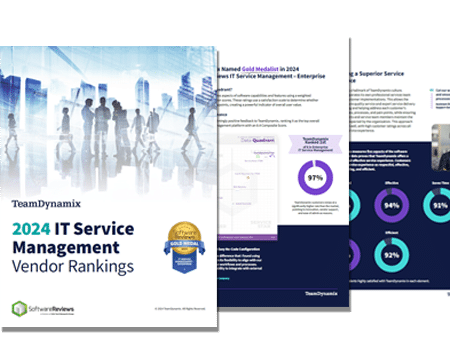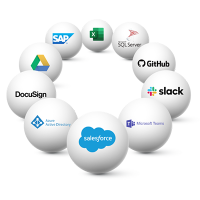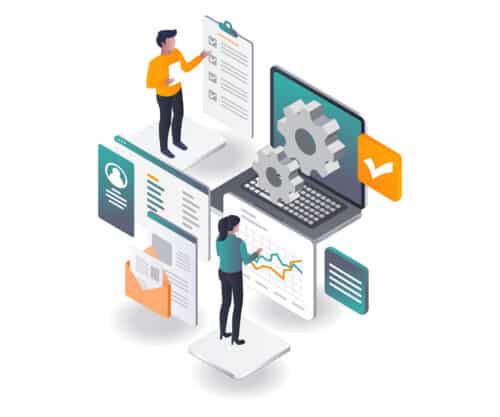
Enterprise Service Management: Why a Unified Platform Matters
Enterprise Service Management (ESM) is the practice of extending IT Service Management (ITSM) principles beyond the IT department to other areas of an organization. ESM

The Info-Tech ranking report offers a unique view of the market based entirely on in-depth customer interviews. Download the Info-Tech ITSM Quadrant and Customer Viewpoint report today.

We’ll show you some of our best situations and show you exactly how to execute them to get immediate results. The best part is, iPaaS tools often feature easy-to-use click and drag functionality, meaning you don’t need a dedicated employee building integrations and workflows.

System Integrators, Value Added Resellers, Technology Providers, and Buying Consortiums can benefit from a partnership with TeamDynamix.

The Info-Tech ranking report offers a unique view of the market based entirely on in-depth customer interviews. Download the Info-Tech ITSM Quadrant and Customer Viewpoint report to gain a better understanding of key vendor strengths and emerging market requirements.
Most of us have used spreadsheets, index cards and sticky notes (or maybe even napkins…) to organize project tasks, especially in our personal lives. But when projects grow into something larger and more complex than those methods can easily support, especially when these projects are intended to deliver some type of benefit to your business, you need a tool specifically built for the job. So, what is Project Portfolio Management (PPM), and how can using PPM software help you?
Well—it can do a lot.
Before we dive into the benefits of PPM software, let’s first cover the basic definition of project portfolio management (PPM). Essentially, a project portfolio is a portfolio that contains all of your company’s ongoing projects. Formalized PPM gives your company a high-level view of all projects that are currently in progress, allowing you to see how and where your time, financial resources and talent are being put to use. This high-level view also lets you see the extent to which your ongoing projects are aligned with your overall business objectives.
These days, the project management office (PMO) usually has so many projects going at once that PPM is almost impossible without designated software. That’s where project management software comes in.
Waterfall, Agile, Kanban, Card Wall, basic task lists—all these project methodologies should be available within your PPM software because you need to fit the methodology to the project (and project team) and not the other way around. And for some projects, a hybrid approach that combines elements of more than one of these is the way to go. By “right-sizing” your project plans for the project you’re undertaking and the team of resources that will be doing the work, you are setting yourself up for success.
With project portfolio management, you get comprehensive support for all projects, regardless of size, complexity or simplicity.
Leverage an intake framework, which will help you compile, analyze, and evaluate the data required to decide which ideas should become projects and which projects should be approved.
COLLABORATION
Project teams are more effective when they can seamlessly collaborate. Sharing notes, discussing issues and risks, and understanding status updates in real-time contribute to top-notch project performance.
DASHBOARDS AND REPORTING
When it comes to project management, there is no bigger mantra than transparency. Gain a consolidated view of projects across the team with custom views and the ability to export or publish publicly.
PROJECT PLANNING
Quickly and effectively plan projects using the right methodology for the job. Speed planning with project templates to support all maturity levels, from simple to complex, using the right fit for each project.
PROJECT MANAGEMENT
Quickly measure and report on the activities, issues, risks, and tasks that have the biggest impacts on successful project completion. Set custom alerts for specific deviations, project health and project status.
RESOURCE MANAGEMENT
Resource constraints are often reported as the number one issue facing IT organizations. PMOs need a clear view of all work and resources across the portfolio for resource capacity planning.
TICKETS AND PROJECTS
Sometimes incidents and service requests need to become projects – and sometimes projects kick off service requests. With a single-platform approach, you can manage both in one place, on one platform.
PORTFOLIO APPROACH
Eliminate surprises and identify potential roadblocks before they occur with a portfolio approach. Establish the framework to keep projects on track, aligned with goals and ensure completion on time and within budget.
While many of your projects might be centered within the IT department, you may also work on projects with other departments, like facilities, marketing, human resources, etc. There are a few things you should consider and that your PPM software should help with.
First is, of course, collaboration. When project work is spread across departments, being able to communicate project-related information clearly and effectively is essential. And speaking of communication, you need to do so with a common language. By communicating with easy-to-understand and jargon-free dialog, you will avoid confusion and foster stronger relationships between departments—and that’s a good thing.
Project teams can range in size depending on the scope of a project. And those resources are often splitting time between multiple projects, or between projects and support tickets. Resource capacity planning allows you to fine-tune resource allocation so that everything is covered, and certain team members aren’t underutilized while others are redlining – making everyone more productive.
The reporting platform integrates project, portfolio, enterprise, and IT Service Management (ITSM) -along with third-party data – to give an unparalleled understanding of the enterprise without the need for expensive third-party reporting tools. Don’t just collect data – use it.
Organizations that operate at the high end of the project management maturity scale are 2.5 times more likely to deliver projects both on schedule and on budget. PPM software will help you forecast project budgets and track resources’ time against that budget so you can make on-the-fly adjustments as needed to keep the project on course.
If your organization has a specific business objective it wants to accomplish, there may be numerous projects that contribute to that overall effort—each with its own timeline, budget and resources. PPM software that allows you to look across all projects within a portfolio is vital. By managing with a portfolio approach—rather than managing projects in isolation—stakeholders can see how everything is tracking and aligned to the strategic needs of the business.
Prior to using TeamDynamix for project management, the team at Kern Family Health Care, a Medi-Cal managed care health plan serving residents of Kern County, California, would maintain a shared spreadsheet with information about projects that were proposed, approved, and underway.
According to LaVonne Banks, director of Kern Health Systems’ enterprise project management office (EPMO), this process was inefficient and project managers did not have easy visibility into the status of projects. Looking to improve its project management process, Kern Health Systems implemented TeamDynamix in the summer of 2021.
With a simple and intuitive user interface, TeamDynamix makes it easy for project managers to evaluate project requests, approve and prioritize initiatives, assign resources and track and report on progress. TeamDynamix helps EPMO staff keep projects on course, establish clear expectations, and allocate resources more effectively.
“With TeamDynamix, I always have a source of truth on project data,” Banks observes.
Using TeamDynamix brings greater transparency to the project management process. It also saves Banks and her staff a great deal of time when they want to understand the status of projects and report this to organizational leaders.
“I love the platform’s reporting features,” she says. “They’re super easy to use. Being able to pull reports and quickly see real-time data is wonderful.”
Another key benefit of TeamDynamix is that it helps EPMO staff get ahead of potential issues before they become full-blown problems. While some challenges are beyond the control of project managers, having greater insight makes it more likely that projects will be completed on time and under budget.
“We can quickly identify resource constraints and make adjustments when unexpected circumstances arise,” Banks says. “Because we can identify these issues earlier, we have a better chance of staying on top of resource management.”
Better transparency leads to more accountability and, ultimately, a higher success rate on projects.
When you consider that project portfolio management tools can cost several times as much for similar features and functionality, “the value of TeamDynamix is incomparable,” Banks concludes.
For organizations wanting to engage in better resource capacity planning across the entire organization, a combined approach to PPM and IT Service Management (ITSM) is the answer. Resource capacity planning allows you to get a big-picture view of your entire IT organization, allowing you to balance workloads across projects and support; and to see the different types of work that need to be done at any given time. This approach is especially useful when you have limited resources, but an increase in demand for the support of remote learning and remote workforces.
There are many benefits to the one-platform approach for ITSM and PPM including:
At the City of Madison, the TeamDynamix platform is being used to support digital transformation initiatives with great success.
Like many other businesses and organizations – the demand for service has gone up exponentially over the last few years as IT now has to support better digital experiences and a “service anywhere, anytime” mentality, even within the public sector.
“Demand for service is skyrocketing, but our staff levels have stayed relatively the same,” Abigail Ferguson, Customer Success Manager for the City of Madison’s Information Technology, said.
To address the growing demand, the City of Madison is taking a proactive approach and combining Project Portfolio Management with ITSM using a single platform through TeamDynamix, “This is going to help us really get a sense of what projects align with our strategic goals. We can see what projects align with our service catalog that exist today and take a more proactive approach with our customers and other agencies,” she said.
And reactively, Ferguson said they really want to lean on utilizing their ITSM tool and tickets to help staff better manage their time and improve efficiency.
“We historically haven’t tracked the amount of time we spend on resolving tickets or on a project or task,” she explained, “So we are asking everyone to do that now using our tool so that we have a better picture of what expenditures do we have (in terms of staff time) and then we can use that to have a holistic view of resources so we can do resource capacity planning.”
Once they know their baseline for certain tasks and projects they’ll be able to identify areas where they might be able to make process improvements and provide a quicker, better customer experience.
This single platform approach for ITSM and PPM is also going to help the city identify what projects should be a high priority and what projects can be turned down or scheduled for a later time, “In government, you can’t always say no – it’s more of a ‘we can do that later’ so we want to be able to support our staff and our citizens the best we can by prioritizing the work,” Ferguson said.
Festival Foods, a grocery store chain that operates about 40 grocery stores and supports 9,000 employees with an IT staff of 40, including a seven-member service desk, also uses TeamDynamix for both ITSM and PPM, as well as iPaaS.
“Before, we had no project governance process,” Alex Turek, IT service desk manager, explained. “It was very ad-hoc. Whoever could scream the loudest got the most IT resources. Finding a tool that also included PPM was huge.”
Managing projects and IT services within the same platform has brought significant benefits, leading to improved efficiency and accountability.
“Technicians can see their project work and their IT work in one space,” Turek said. “This means it’s easier to communicate and ensure follow-through. Project managers can assign tasks to my service desk team within the same dashboard they’re using to resolve tickets. Those pop right up, helping them be aware of all their tasks and priorities so they can easily meet their deadlines.”
The next step for Turek and his team is to leverage the integrated Platform-as-a-Service (iPaaS) capabilities within TeamDynamix to automate their most repetitive processes.
“We’re looking to automate tasks such as password resets, user account deactivation, user onboarding and other tasks we do often, so we can reduce the daily workload on our team,” Turek said.
Want to learn more about the benefits of bringing ITSM and PPM together with iPaaS? Check out:
This post was originally posted in November 2020 and has been updated with new information.

Enterprise Service Management (ESM) is the practice of extending IT Service Management (ITSM) principles beyond the IT department to other areas of an organization. ESM

As businesses grow, so does the complexity of managing their services. This is where Enterprise Service Management (ESM) comes in, offering a structured approach to

As IT departments modernize their service management tech stacks, automation stands out as a pivotal force driving significant transformations in how the IT service desk
TeamDynamix’s award-winning SaaS cloud solution offers IT Service and Project Management together on one platform with enterprise integration and automation.
[email protected]
(877) 752-6196
Contact Us
